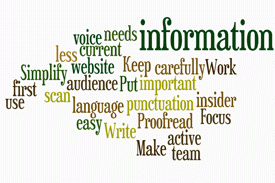Writing for the Web—Don't listen to your English teacher!
Most of us learned how to write in a system that encouraged us to fill the page. Remember when a teacher said to write two pages, single-space? We filled our papers with adjectives, extra details and asides. Nothing could be further from the goal in writing for the web.
Why is writing for the web different?
The typical web user is active and engaged. They have an agenda—something they want to find. Most commonly, the reader has limited time and definitely limited patience. When I counsel clients on this topic, I try to paint a picture by saying "Imagine a parent of small children with children running around them screaming." With this visual picture, it is clear that we need to have a focused message to be heard over the "noise" in our culture.
Here are 10 tips on writing for the web
- Focus on the needs of your audience.
- Say less.
- Put most important information first.
- Make the information easy to scan.
- Simplify punctuation.
- Don't use "insider" language.
- Write in active voice.
- Keep your website current.
- Proofread carefully.
- Work with a team.
We're planning a webinar to expand on these topics with examples and exercises to get you thinking. What do you think? Would you attend?
Get updates on the webinar
If you're interested in learning more about this webinar, please sign up for our webinar interest list. You'll be the first to know when this webinar is announced, and will have priority when registering.
MONTHLY MARKETING INSIGHTS.
Get thought-provoking and actionable insights to improve how your firm makes a connection with your customers.





LEAVE A COMMENT